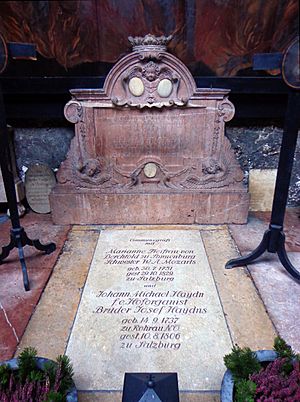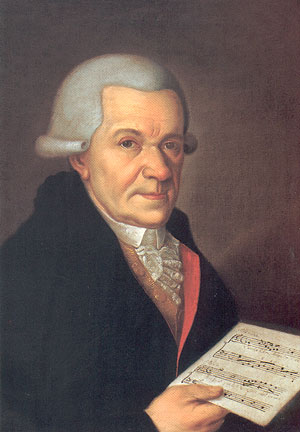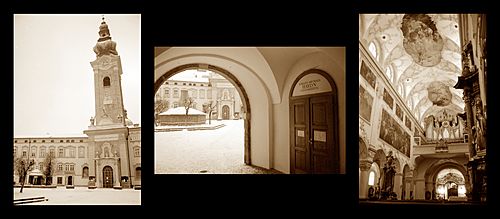Michael Haydn facts for kids
Johann Michael Haydn (born September 14, 1737 – died August 10, 1806) was an Austrian composer. He lived during the Classical music period. He was the younger brother of the famous composer Joseph Haydn.
Contents
Life Story of Michael Haydn
Michael Haydn was born in 1737 in a small Austrian village called Rohrau. His father, Mathias Haydn, was a wheel maker and also like a village mayor. His mother, Maria, used to work as a cook. Michael's father loved folk music and taught himself to play the harp. He made sure all his children learned to sing.
Early Music Training
When Michael was eight, he moved to Vienna. His older brother, Joseph, had already become a boy soprano in the choir at St. Stephen's Cathedral. Joseph helped Michael join the same choir. Michael was a very talented student. By the time he was 12, he was already earning money as a substitute organist at the cathedral. He even played his own music!
People said Michael was a brighter student than Joseph. When Joseph's voice changed, Michael's singing was more admired.
Career in Salzburg
Around 1753, Michael left the choir school when his voice changed. In 1760, he became a music director in Großwardein (now Oradea). Later, in 1762, he moved to Salzburg and became a concertmaster. He stayed in Salzburg for 44 years. During this time, he wrote over 360 pieces of music. These included both church music and instrumental music.
In Salzburg, Haydn met Mozart. Mozart thought highly of Haydn's music. Michael married a singer named Maria Magdalena Lipp in 1768. They had one daughter, Aloisia Josepha, who sadly died before her first birthday.
Michael also taught music to young students in Salzburg. Two of his students became famous composers themselves: Carl Maria von Weber and Anton Diabelli.
Family Connections

Michael remained very close to his brother Joseph throughout his life. Joseph greatly admired Michael's music. He even thought Michael's religious music was better than his own. In 1802, Michael was offered good jobs by other important people. He asked Joseph for advice but decided to stay in Salzburg. Michael Haydn passed away in Salzburg when he was 68 years old.
Michael Haydn's Musical Works
Many music experts believe Michael Haydn deserves more recognition. His church music, songs for male voices, and many instrumental pieces are considered very good. They think these works should be played more often today.
Michael Haydn did not make a list of all his own works. Later, music experts created catalogs to organize his compositions. This was made easier because he usually wrote the date on his music papers.
Sacred Music
Haydn's church music is often seen as his most important work. His talent for music showed best in these pieces. Some of his famous sacred works include:
- The Requiem pro defuncto Archiepiscopo Sigismundo (a special mass for the dead). This piece greatly influenced Mozart's own Requiem.
- His Missa Hispanica (a type of mass).
- His last St. Francis Mass in D minor.
He also wrote many other church pieces, like motets and graduals.
Secular Music
Haydn also wrote a lot of non-religious music. This included:
- 41 symphonies.
- Many wind partitas.
- Several concertos (music for a solo instrument with an orchestra).
- Chamber music, like a string quintet.
Sometimes, people thought Michael Haydn's music was written by other famous composers. For example, his Symphony No. 25 was once thought to be Mozart's Symphony No. 37. It turned out that Mozart only wrote a small part of the beginning, and the rest was by Michael Haydn.
Michael Haydn's music actually influenced Mozart quite a bit. For instance, parts of Haydn's symphonies and other works inspired Mozart's own compositions.
List of Michael Haydn's Music
Michael Haydn wrote a huge amount of music during his life. He composed many different types of pieces, including:
- Over 40 symphonies and many concertos.
- Lots of chamber music, like quintets and quartets.
- Numerous pieces for keyboard instruments.
- A large collection of sacred vocal music, such as masses, cantatas, and hymns.
- Secular vocal music, including operas, songs, and part-songs.
See also
 In Spanish: Michael Haydn para niños
In Spanish: Michael Haydn para niños




